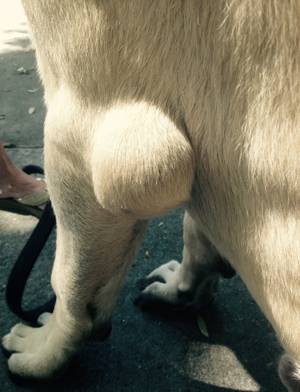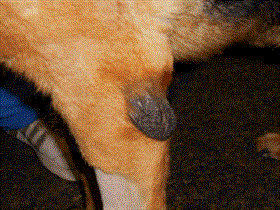
The classical appearance of an uncomplicated elbow hygroma. Photo by Dr. Allison Witherow
The usual patient for this condition is a short-haired, large breed dog, usually an adolescent, brought to the veterinarian for a fluid-filled swelling at the point of one or both elbows. The swelling is generally non-painful but can be quite bulbous and bizarre looking.
What has happened is relatively simple: the dog has most likely been resting on a fairly hard surface and the pressure of their weight has created tissue damage over the elbow bones. The area is not able to heal because of the repeated tissue damage from the dog simply resting on their elbows. A fluid pocket forms as the body attempts to create its own cushion. This fluid pocket is called a hygroma. The most common location for a hygroma is the elbow, though they can occur on the "sit bones" of the pelvis as well.
The Uncomplicated Hygroma
The simple or uncomplicated hygroma is not painful and is mostly of cosmetic concern. Changing the dog’s bedding generally solves the problem though sometimes elbow pads or bandages must be constructed or purchased. If the dog begins to lie on softer, more pliant materials, the hygroma is likely to simply resolve over two to three weeks as the inflammatory tissue is able to scar down. It is best not to tap off the fluid as any time the hygroma is pierced, infection can be introduced, potentially creating a complicated hygroma. Surgery on a hygroma should be avoided if possible for reasons described later on.
Treatment for uncomplicated hygroma is basically changing the bedding or surface upon which the dog lies.
The Complicated Hygroma
Healing complicated hygroma

Complicated hygroma after surgical healing is complete. The callus did not require removal here. Photo by MarVistaVet.
If the hygroma becomes infected, it will become tender and surgical drainage becomes necessary. If the surface of the hygroma is not ulcerated, it can be drained and flushed. Rubber drains can be inserted into it to allow for further drainage into bandages. The bandages should be changed daily but it should resolve after a couple of weeks. If only drains are needed and no trimming is needed, the natural callus on the elbow will be preserved to protect the area; any surgery that disrupts the natural callus is asking for trouble.
Any time a hygroma is lanced and opened, the potential exists for the area to be unable to heal. After all, the reason the hygroma formed in the first place is because the damaged soft tissue was unable to heal. The extensive motion of the elbow area also hampers healing. Establishing soft bedding is critical. If the hygroma is infected, there is no choice but to flush and drain it.
Treatment for the infected but not ulcerated hygroma is placing a surgical drain in addition to changing bedding as above.
If the hygroma is severely proliferative or chronically draining, or basically has a big sore on it, a more extensive surgery is needed. The callus is too far gone and must be removed. Skin flaps or even grafts may be needed to reconstruct the skin after the infected callus is removed. A splint will likely be needed to sufficiently pad and immobilize the leg during healing, which takes a month or so. As mentioned, the motion of the area works against healing, and removing the natural callus and elbow soft tissue is also an obstacle.
It is important to recognize the hygroma early in its course so that it need not progress to a complicated status. If you are unsure about any swelling on a pet, see your veterinarian promptly.
Other Hygromas
Technically, a hygroma can form over any bony protuberance that repeatedly receives the patient's weight. The elbow is the most common area to form a hygroma but the "sit bones" of the pelvis is the second most likely area. These are called ischial hygromas and look like swellings under the tail right where the dog sits down. Again, softer bedding generally resolves the problem.